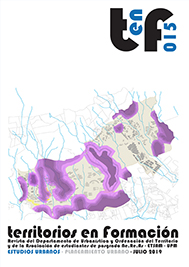Uso de los Sistemas Globales BREEAM-CM y LEED-ND en Asunción, Paraguay = Use of the BREEAM-CM and LEED-ND Global System in Asunción, Paraguay
DOI:
https://doi.org/10.20868/tf.2019.15.4006Palabras clave:
Barrios sostenibles, certificación de barrios, sistemas globales de certificación, Sustainable neighbourhoods, neighbourhood certification, global certification systemsResumen
Resumen
Los Sistemas Globales de Certificación de Sostenibilidad Barrios BREEAM-CM y LEED-ND han sido desarrollados en países de primer mundo, donde las normativas de construcción son altamente exigentes. Actualmente, se encuentran muy presentes en Latinoamérica, incluso en países como Paraguay, donde aún no existe un marco sólido sobre el cual anclar el desarrollo sostenible de las ciudades. El objetivo de esta investigación es verificar la viabilidad de estos sistemas globales en un contexto distinto al de su origen, como Asunción. Es la primera vez que se analiza al detalle la aplicación de las especificaciones técnicas de estos sistemas en este entorno y, para ello, se han creado parámetros con los cuales poder verificar qué requerimientos y especificaciones son posibles, imposibles o necesitan ser discutidos con profesionales del área, antes de considerar conveniente su aplicación. Como resultado, se ha constatado que ambos sistemas necesitan modificar o flexibilizar ciertos requerimientos y especificaciones obligatorios, cuyo incumplimiento impide actualmente la certificación de barrios en Asunción. Finalmente, se ha desarrollado una metodología capaz de verificar la viabilidad de implantación de estos sistemas no sólo en Asunción, sino en cualquier ciudad del mundo.
Abstract
The Global Sustainability Certification Systems Neighborhoods BREEAM-CM and LEED-ND have been developed in first world countries where construction regulations are highly strict. Currently, they are very present in Latin America, even in countries like Paraguay, where there is still no solid framework on which to anchor the sustainable development of cities. This research is to verify this global systems feasibility in a different context from their origin, such as Asunción. It is the first time that the application of the technical specifications of these systems is analyzed in detail in this environment, and, for this purpose, new parameters have been created in order to verify which requirements and specifications are possible, impossible or need to be discussed with local professionals before considering its application as meaningful. As a result, it has been found that both systems need to modify or flexibilize certain mandatory requirements and specifications, the failure of which currently prevents the neighborhoods certification, and through this will be able to work in Asunción. Finally, it has been developed a methodology capable of verifying the feasibility of implementing these systems not only in Asunción, but in any city in the world.
Descargas
Referencias
ASU (ed.) (2016). Plan de Desarrollo Sustentable Asunción 2030. Asunción: Gobierno Municipal de Asunción. Recuperado de: https://nube.stp.gov.py/index.php/s/fbGjaDhSlwnNLWZ
BID (ed.) (2014). Plan de Acción, Área Metropolitana de Asunción sostenible. Banco Interamericano de Desarrollo. Recuperado de:
https://webimages.iadb.org/PDF/Plan+de+Acci%C3%B3n+ICES+Asunci%C3%B3n.pdf
BRE (ed.) (2018). Green book live. Recuperado de: www.greenbooklive.com
BRE GLOBAL (ed.) (2012). BREEAM Communities Technical Manual: SD 202.Version: 2012 Issue: 1.2. Recuperado de: https://www.breeam.com/communitiesmanual/
DGEEC (ed.) (2015). Paraguay Proyección de la población por sexo y edad, según Distrito, 2000-2025. Fernando de la Mora: Dirección General de Estadística, Encuesta y Censos. Recuperado de: https://web.archive.org/web/20151016011537/http://www.dgeec.gov.py/Publicaciones/Biblioteca/proyeccion%20nacional/Proyeccion%20Distrital.pdf
DGEEC (ed.) (2002). Atlas censal del Paraguay. Fernando de la Mora: Dirección General de Estadística, Encuesta y Censos. Recuperado de:
FARIÑA, J. (2013). El urbanismo en la UE: no sabe, no contesta. El blog de José Fariña, urbanismo territorio y paisaje. ISSN: 2605-3306. Recuperado de: http://elblogdefarina.blogspot.com.es/2013/04/el-urbanismo-en-la-ue-no-sabe-no.html
HAAPIO, A. (2012). Towards sustainable urban communities. Environmental Impact Assessment Review, 32 (1), 165 – 169. DOI:10.1016/J.EIAR.2011.08.002.
KYRKOUA, D. y KARTHAUSA, R. (2011). Urban sustainability standards: predetermined checklists or adaptable frameworks? Procedia Engineering, 21, 204 - 211. DOI:10.1016/J.PROENG.2011.11.2005.
REITH, A. y OROVA, M. (2014). Do green neighborhood ratings cover sustainability? Ecological Indicators, 48, 660 – 672. DOI: 10.1016/J.ECOLIND.2014.09.005.
SEAM/PNUD (ed.) (2017). Plan Nacional de Mitigación al Cambio Climático. Asunción. Recuperado de: http://archivo.seam.gov.py/sites/default/files/users/comunicacion/PLAN%20NACIONAL%20DE%20MITIGACI%C3%93N%20Y%20LOS%20PROGRAMAS%20DE%20ACCI%C3%93N_0.pdf
RUEDA, S. (2012). Guía Metodológica para los Sistemas de Auditoría, Certificación o Acreditación de la Calidad y Sostenibilidad en el Medio Urbano. Barcelona: Ministerio de Fomento. Recuperado de: http://www.upv.es/contenidos/CAMUNISO/info/U0596879.pdf
SHARIFI, A. y MURAYAMA, A. (2012). A critical review of 7 selected neighborhood sustainability assessment tools. Environmental Impact Assessment Review, 38, 73 – 87. DOI: 10.1016/J.EIAR.2012.06.006.
SPAIN-GBC (ed.) (2014). LEED v4, Desarrollo urbano. Recuperado de:
http://www.spaingbc.org/files/LEED%20v4%20ND%20ESP.pdf
USGBC (ed.) (2018a). Country market brief. Recuperado de: https://www.usgbc.org/advocacy/country-market-brief
USGBC (ed.) (2018b). LEED 2018 for Neighborhood Development, Technical Manual. Washington, DC: US Green Building Council. Recuperado de: http://www.usgbc.org/leed
USGBC (ed.) (2009). LEED 2009 for Neighborhood Development, Technical Manual. Washington, DC: US Green Building Council. Recuperado de: https://www.usgbc.org/resources/leed-2009-neighborhood-development-current-version
WALLHAGEN, M., GLAUMANN, M., ERIKSSON, O. y WESTERBERG, U., (2013). Framework for detailed comparison of building environmental assessment tools. Buildings, 3, 39 – 60. DOI:10.3390/BUILDINGS3010039.
WANGEL, J., WALLHAGEN, M., MALMQVIST, T. y FINNVEDEN G. (2015). Certification Systems for Sustainable Neighborhoods: What do they really certify? Environmental Impact Assessment Review, 56, 200 – 213. DOI:10.1016/J.EIAR.2015.10.003.









